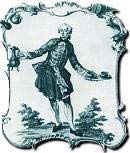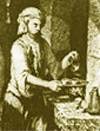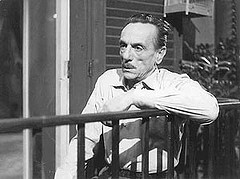

Questi fantasmi - Atto II
Eduardo De Filippo
PASQUALE (al balcone mentre parla col Professor Santana): ..(...)..Chi mai
potrebbe prepararmi un caffe' come me lo preparo io, con lo stesso zelo
...con la stessa cura?...Capirete che , dovendo servire me stesso , seguo le
vere esperienze e non trascuro niente.........Sul becco...........lo vedete il
becco?...(...)...sul becco io ci metto questo coppitello di carta...Pare niente,
questo coppitello, ma ce l'ha la sua funzione ...E gia', perche', il fumo
denso del primo caffe' che scorre, che poi e' il piu' carico, non si disperde.
Come pure, professore, prima di colare l'acqua, che bisogna far bollire per
tre o quattro minuti, perlomeno, prima di colarla, vi dicevo, nella parte
interna della capsula bucherellata, bisogna cospargere mezzo cucchiaino di
polvere appena macinata. Un piccolo segreto! In modo che al momento
della colata l'acqua in pieno bollire, gią sia aromatizzata per conto suo.
Professore anche voi vi divertite qualche volta, perche', spesso, vi vedo
fuori al vostro balcone a fare la stessa funzione. ..(...)..siccome mia moglie
non collabora, me lo tosto da me...Anche voi professore?.. E fate bene...
Perche', quella, poi, e' la cosa piu' difficile: indovinare il punto giusto di
cottura, il colore....A manto di monaco....Color manto di monaco. E' una
grande soddisfazione, ed evito pure di arrabbiarmi, perche' se per una
dannata combinazione, per una mossa sbagliata, sapete, vi scappa di
mano il pezzo di sopra, si unisce a quello di sotto, e si mescola posata e
caffe'...Insomma viene una schifezza...Siccome l'ho fatto con le mie mani e
non me la posso prendere con nessuno, mi convinco che e' buono e me lo
bevo lo stesso.....Professore e' passato. (versa il contenuto nella tazzina)
Ecco qua! Caspita, che caffe'! E' cioccolata! Vedete quanto poco ci vuole per
rendere felice un uomo: una tazzina di caffe', presa tranquillamente qui
fuori....con un simpatico dirimpettaio....voi siete simpatico, professore....
vedete, mezza tazzina me la conservo, me la bevo tra una sigaretta e
l'altra (accende una sigaretta)...........(...)....

Bring it to his lips a cup of steaming coffee is a common gesture in much of the world, but few places are questions about the origin of the beverage, its history, its social significance. On its origins, there are many legends. Everyone knows that goats, in a convent Muslim Yemen, began hopping mad after having nibbled leaves and berries of a shrub in the mountains: the curious monks used it as a tea ...
Less-known legend about Muhammad is said that one day the Prophet felt very ill, the Archangel Gabriel came to the rescue, bringing him a potion received directly from Allah. The drink was dark as the Sacred Black Stone of Mecca, commonly called "qawa". Mohammed drank, he brightened up suddenly and left for large enterprises. Another ancient legend told of a beverage source of ecstasy, capable of carrying the spirit up to the heavenly spheres.
The History of Coffee
The most famous story (told to the students from the Maronite monk Nairone Antonio Fausto, professor of theology at the Sorbonne in 1700) said, however, that in Arabia a shepherd named Kaddi, having brought his goats to pasture, they noted with astonishment that, after having eaten the berries of a spontaneous plant, showed signs of excitement. The pastor does not riuscendosi to explain what happened, subjected him to the old abbot Yahia. He, realizing that those were the properties of the plant, made a bitter drink and full of heat, warming the body reinvigorated it, freeing it from sleep and fatigue. A similar legend wants, however, that coffee was discovered by an Arab Iman of a monastery, where he prepared a decoction and he enjoyed all the monks of the convent, who stayed awake all night without fatigue. Another story tells of a monaco Arab Sheik Ali Ben Omar, who was only during a trip to Moka City, where he was accompanying his master Schadeli, died during the journey. An angel appeared, was encouraged to go to that city, where a terrible plague raged. Here, with his prayers to Allah, he was able to heal many sick people and even the king's daughter, whom she fell in love. The King, however, removed the monaco, who, forced to live in the solitude of the mountain, to satisfy hunger and thirst, had to invoke the help of his teacher, who sent him a magnificent bird with colorful feathers and persuasive hand. Aroused and raised by the melodious singing, Omar came to admire the bird, and he reached the place, he saw a tree covered with white flowers and red fruits: the coffee plant. He took some berries and made a decoction from the health benefits that are often offered to pilgrims who received her shelter. Sparsasi the news of the magical qualities of the drink, the monaco was welcomed back with great honor in the kingdom.
The coffee in the Napoleonic period.
A final legend, a huge fire spread in a vast territory of Abyssinia, covered with wild plants of coffee, by spreading to tens of kilometers away the flavor of what could be considered a giant roasting naturale.Ulteriori legends traces the origins of coffee to the highlands of Abyssinia, where, apparently, are his true origins.
However, the reports of many travelers testify that the use of coffee was diffused throughout the Islamic East in the late sixteenth century.
In the West the coffee spread through Venice, where, we think, may have opened the first "Coffee Shop" in 1640, although some believe that it has been opened previously in Livorno. In any case, success was immediate and coffee, both as drink and as local spread in every Italian city.
The spread of coffee in the world was facilitated by a struggle of interests between those who wanted to preserve the exclusivity of precious plants and who wanted to take a share of profits that they procured.
In 1690, a command of Dutch sailors landed on the coast of Mocha, Yemen, and managed to get hold of some plants: after a few years, the first plantations flourished in Java and Sumatra. Later, coffee spread violently across the Central and South America where, especially in Brazil, there are still the largest plantations in the world.
